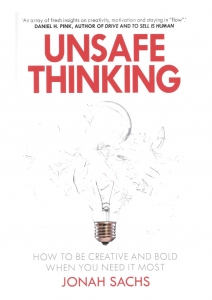The one sentence summary
Most thinking is too safe so to be properly creative we need unsafe thinking.
WHAT THE BOOK SAYS 
- To be creative and bold you need to break out of Safe Thinking using:
- Courage: seek moments of low arousal so you can think properly, accept anxiety as part of the journey, and reimagine fear as fuel for creativity.
- Motivation: focus on intrinsic motivation and avoid (most) extrinsic distractions; get in flow; allow for some distraction (new stimulus).
- Learning: do things that make you a beginner again, don’t bother trying to look like an expert; don’t seize and freeze (grab hold of a fast solution and become wedded to it)– put off important decisions for as long as possible.
- Flexibility: pay attention to your intuitions, but don’t trust them blindly – instead, chip away at your biases.
- Morality: practice a certain level of disobedience, and teach it to others – never follow orders blindly.
- Leadership: resist quick-forming consensus, make it safe to get unsafe, and incentivize risk tasking, not just success.
- Embrace cognitive dissonance by asking:
- What do our most persistent critics say about us and what’s the grain of truth in it? How can we improve things?
- What do we say in our mission statement or values but never get round to doing because we suspect it is too expensive?
WHAT’S GOOD ABOUT IT
- To be successful with creative endeavours, you need to work in two different modes: first open and then closed. Open is relaxed, expansive, less purposeful, without pressure. Closed is impatient, getting on with it, reaching a conclusion.
- Experts who “know too much” get locked into a fixed way of thinking, which is why they are bad a prediction.
- “Intuition is analysis frozen into habit.” Herbert Simon
- When trying to learn something new, we start in the cognitive phase. We have nervous excitement and make a lot of mistakes, such as when learning a new language. Fluency moves us to the automatic phase.
- To get in flow, you need a decent challenge, which creates some anxiety but relieves boredom and increases skill.
- Agreeable people don’t much done because they spend too much time trying to appease everyone.
- A recent study found that millennials are more forgetful than over 55s. They check their phones an average of 85 times a day (the average is 46).
- 10% of the US workforce spends more time on social media than working.
WHAT YOU HAVE TO WATCH
- If you read widely, you will have seen most of the material and examples before. If not, this is a good compendium of all creative thinking.
